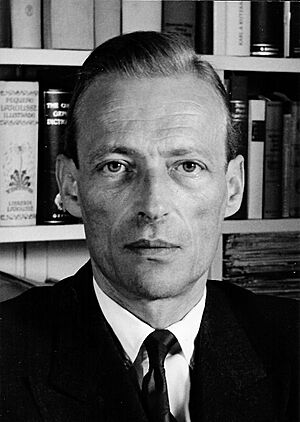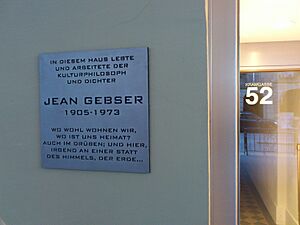Jean Gebser facts for kids
Quick facts for kids
Jean Gebser
|
|
|---|---|

Jean Gebser (1957)
|
|
| Born | 20 August 1905 |
| Died | 14 May 1973 (aged 67) Wabern bei Bern, Switzerland
|
| Nationality | Swiss |
| Era | 20th-century philosophy |
| Region | Western Philosophy |
| School | Phenomenology |
|
Main interests
|
phenomenology of Consciousness |
|
Influenced
|
|
Jean Gebser (born Hans Karl Hermann Rudolph Gebser; August 20, 1905 – May 14, 1973) was a Swiss philosopher, linguist, and poet. He is known for his ideas about how human consciousness changes over time.
Contents
Biography
Jean Gebser was born Hans Karl Hermann Rudolph Gebser in Posen, which was part of Imperial Germany (now Poland). His father was a lawyer.
In 1929, he left Germany. He lived for a while in Italy and then in France. He then moved to Spain, where he quickly learned Spanish. He worked for the Spanish government in the Ministry of Education.

Before the Spanish Civil War started, he moved to Paris, and then to Southern France. It was here that he changed his German first name "Hans" to the French "Jean." He later fled to Switzerland in 1939, just hours before the border closed. He lived near Bern for the rest of his life, where he wrote most of his books.
Even when he was older, Gebser traveled a lot. He visited India, the Far East, and the Americas. He wrote several more books and was also a published poet. Jean Gebser passed away in Wabern bei Bern on May 14, 1973. His personal writings are kept at the Gebser Archives at the University of Oklahoma.
Consciousness in Transition
Gebser's main idea was that human consciousness is always changing. He called these changes "mutations" because they are big jumps, not slow, continuous steps. These changes affect both our mind and body. Gebser believed that older ways of thinking still exist alongside newer ones.
He defined consciousness as "presence" or "being present." It's about being fully aware and awake.
Each way of thinking eventually becomes less useful and is replaced by a new one. Gebser saw the stress and chaos in Europe from 1914 to 1945 as a sign. He believed it showed that an old way of thinking was ending, and a new form of consciousness was beginning. He first noticed this in new ways people used language and literature. Later, he also saw changes happening in the arts and sciences.
His idea that one way of thinking fails while a new one appears made him wonder if this had happened before. His book, Ursprung und Gegenwart, explored this question. It was published between 1949 and 1953 and later translated into English as The Ever-Present Origin. Gebser looked at history through many fields, like poetry, music, visual arts, architecture, philosophy, religion, and physics. He found signs of different consciousness structures appearing and fading throughout history.
Structures of Consciousness
Gebser identified five main structures of consciousness:
- The archaic structure
- The magic structure
- The mythical structure
- The mental structure
- The integral structure
Archaic Structure
The archaic structure is the very first way consciousness appeared. The word "archaic" comes from the Greek word arce, meaning "beginning" or "origin." This origin is the source of everything.
We don't have direct information about this structure. We can only guess about it from later writings. In this stage, consciousness is like a "dimly lit mist." People were not individuals but felt completely connected to everything around them. They were "totally identical with the world."
Magic Structure
In the magical structure, events, objects, and people are connected by magic. Symbols and statues don't just represent things; they are those things.
Gebser described this as a "one-dimensional" way of thinking. Unlike the archaic structure, where humans and the universe were one, here humans start to notice nature as something separate. They feel they must "listen" to nature and act based on it to survive.
Mythical Structure
Gebser described the "two-dimensional" mythical structure as a circle, representing cyclical time. This is based on humans noticing the repeating patterns in nature and thinking about their experiences. The main feature of the mythical structure is the awareness of the "soul." In this structure, events, objects, and people are linked together through stories. Myths help people make sense of the world.
An important part of myth is polarity, meaning two opposite ideas existing together. For example, the word myth means both speaking and silence. Gebser explained that this idea of opposites makes myth hard for the mental way of thinking to understand. The mythical world doesn't need strict rules because it accepts these opposites.
Mental Structure
The mental structure understands events, objects, and people using logic. In its strong form, the mental structure is "three-dimensional." Gebser used the "triangle" to show this, with two opposing ideas at the bottom that come together at the top. This is like a thesis, antithesis, and synthesis. Gebser saw this as the start of logical thinking, which helped build Western science. Words became more about clear ideas and less about images or power.
The weaker form of the mental structure is what Gebser called the 'rational' structure. This way of thinking tries to deny other structures, claiming that humans are only rational.
The rational structure can lead to extreme views, like saying "everything is nothing but matter — atoms." Instead of seeking wisdom, people focus on what they "can do." Thinking deeply becomes less important than taking action. This focus on technology can solve some problems but also create new ones. Gebser saw that this way of thinking, if taken to an extreme, could lead to a feeling of meaninglessness.
He believed that trying to fix this by just adding "values" wouldn't work. The problem was with the structure of consciousness itself. But through this difficult period, Gebser saw the start of a new consciousness, which he called the integral structure.
Integral Structure
The integral consciousness structure showed a new way of relating to space and time. Gebser noted how time was being included in physics and how artists tried to show time in their work. He saw that the integral structure was largely about time breaking into the "fixed-reality" of the mental structure. For Gebser, old, separate ideas like mind and body started to become transparent.
"Transparency" means that one thing is "seen through" and always "with" another. For a long time, time was seen as separate parts: past, present, and future. This caused problems in understanding how things moved from one part to another. Integral awareness realizes that even though we use these categories, time is an unbroken whole. Things in the present come from the past and reach into the future. Without an integral awareness, we couldn't even understand "past" or "present."
Gebser introduced the idea of presentiation. This means making something present through transparency. A key part of integral awareness is bringing all the different structures of awareness into the present. Instead of only one (rational) structure being seen as valid, all structures are recognized and seen through each other. This understanding helps us live through the different structures, rather than being controlled by them.
It's hard to recognize these different structures in our language, habits, and even in ourselves. But Gebser said we can't ignore this task without losing ourselves. He believed that our "objective thinking" has consequences. Living "objectively" can lead to a feeling of meaninglessness, especially when combined with powerful technology. He asked if we are tired of these problems and if we are willing to change. He suggested that just as there is a time for action, there is also a much-needed time for quiet thought. In a world that values "know-how" too much, simple "knowing" must also be cared for. He also believed that what we think shapes who we are.
Terminology
Discontinuity
Gebser warned against using words like evolution, progression, or development to describe the changes in consciousness structures. He felt these words didn't fit.
He explained that biological evolution is about a species becoming specialized for a certain environment. But the unfolding of awareness is the opposite; it's about opening up to more possibilities.
Trying to give a direction or goal to awareness is misleading. It's based on a limited, linear idea of time. Gebser said that "to progress" means moving towards something and away from something else. So, progress is not the right word for consciousness structures. He believed that the future of humanity is still open. If it became closed, that would be a tragedy. Our future is not guaranteed by any idea of "evolution towards" a perfect state.
Space and Time
Gebser noted that each consciousness structure shows itself through how it relates to space and time. For example, the mythical structure sees time as cyclical (repeating) and space as enclosed. The mental structure sees time as linear (straight line) and space as the empty, box-like space of geometry.
Influence
Jean Gebser's work has influenced many other studies and writers.
Ken Wilber
Ken Wilber, another philosopher, often mentioned Gebser in his books. Wilber found Gebser's ideas about consciousness to match his own. Wilber also suggested there might be even more spiritual stages beyond Gebser's integral structure.
William Irwin Thompson
In his book Coming into Being (1996), cultural critic William Irwin Thompson compared Gebser's consciousness structures to Marshall McLuhan's ideas about how communication technology developed. Thompson also applied these ideas to education theory. Later, he connected Gebser's structures to periods in the history of mathematics and history of music.
New Age
Gebser's integral philosophy is discussed in some New Age books. For example, Daniel Pinchbeck's book 2012, The Return of Quetzalcoatl (2006) looks at Gebser's ideas about a new shift in consciousness. Gary Lachman's A Secret History of Consciousness (2003) links Gebser's work to other thinkers like Owen Barfield and Rudolf Steiner.
Other Influences
Gebser's ideas have also influenced:
- Rudolf Bahro's Avoiding Social and Ecological Disaster
- Bernardo Kastrup's Why Materialism Is Baloney
- Hugo Enomiya-Lassalle's Living in the New Consciousness
- Daniel Kealey's Revisioning Environmental Ethics
- Georg Feuerstein's Wholeness or Transcendence
- Eric Mark Kramer's Modern/Postmodern: Off the Beaten Path of Antimodernism
- Grant Maxwell's The Dynamics of Transformation: Tracing an Emerging World View
See also
 In Spanish: Jean Gebser para niños
In Spanish: Jean Gebser para niños
- Perspective
- Spiral Dynamics
- Fowler's stages of faith development
- Integral Theory

